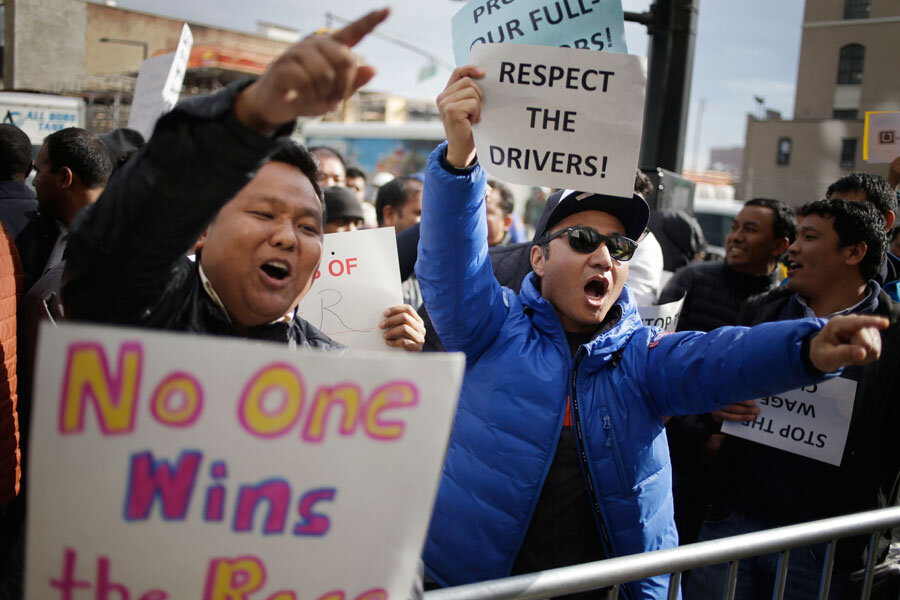How happy are Uber drivers? Not very, study finds.
Loading...
A December survey conducted by Uber showed 81 percent of all drivers said they were satisfied with their overall experience with the company. Ninety-seven percent said they were satisfied with the flexibility of their schedule and 91 percent were satisfied with their work-life balance.
But not all Uber drivers are starry-eyed, a new survey released Monday suggests. Harry Campbell, author of The Rideshare Guy a popular blog for rideshare drivers, asked his 10,234 e-mail subscribers to rate their experience with Uber. Of the 453 who responded, only 48 percent are happy with their employer.
And while the two surveys cannot be definitively compared – Uber used a professional polling company and Campbell gave his readers an amateur questionnaire – the new poll results highlight an ongoing competition between Uber and Lyft to court drivers.
A common perception of the difference between Uber and Lyft is that Lyft is a better company to work for, but Uber brings in higher pay.
“Imagine how many more drivers would prefer Lyft over Uber if they actually made the same amount of money as they did driving for Uber!” says Campbell in his survey.
But Uber’s claim to fame among drivers – that it offers the highest wages in the game – is slowly eroding.
To increase business during the slow winter months, Uber recently cut fares for passengers, and thus salaries for drivers, in over 100 cities
“They’ve got a dominant share on the market of drivers right now since they provide the best earning opportunities, but they face some serious risks in the future,” Campbell tells The Verge. “There hasn’t been a whole lot of loyalty on either side, and drivers are starting to take notice of other opportunities and go wherever the grass is greener.
Tim Reinhart, an Uber driver from Indianpolis, switched to Lyft for a week and wrote about his experience on Campbell’s blog.
“Uber kept me busier, but Lyft might be more profitable,” Reinhart concluded at the end of his trial week.
Instead of 10 $6 rides with Uber on a typical Monday, Reinhart gave six $10 rides on Lyft, which he said attributed to a better overall driver experience. Not only did he have the opportunity to form relationships with his passengers, but he also had longer segments of idle time to get a coffee or read a book.
Reinhart says he saw other Lyft-exclusive benefits that week: over half of his Lyft customers were “toes on the curb” upon his arrival, an in-app tipping feature led to extra revenue and the company offered periodic bonuses for driving during certain heavy-traffic shifts.
“Adding in cash tips and a 20% bonus that I NEVER get from Uber, I made 1.5 times my usual weekly income and spent less time working,” says Reinhart. “It looks like for now, I’m a Lyft driver.”
Uber claims that drivers average $19 per hour nationally, and up to $30.35 per hour in New York City.
“Uber has publicly touted wage data that aims to prove that the company’s ride-sharing opportunity is the most lucrative in the industry and, after examining raw pay stubs, I found that those averages largely hold true,” explains BuzzFeed reporter Johana Bhuiyan, who went on 11 random Uber rides with 11 random drivers to see if the company’s own projections held true on the ground. “A deeper examination, however – one that accounts for the number of logistical and monetary expenses Uber drivers regularly incur – paints a much bleaker picture of what these drivers are actually making on average.”
Many of the drivers Bhuiyan interviewed said weekly expenses like gas, toll fees, insurance and car maintenance detract the company’s impressive averages. In a company report last year, 11 percent of drivers said they actually lost money after being their employment with Uber.
“You can make $25 an hour,” Uber driver Yilmaz Genc tells Bhuiyan. “Maybe I’ll make $25, but who is going to pay for my car? I pay tax, car, and my insurance.”








